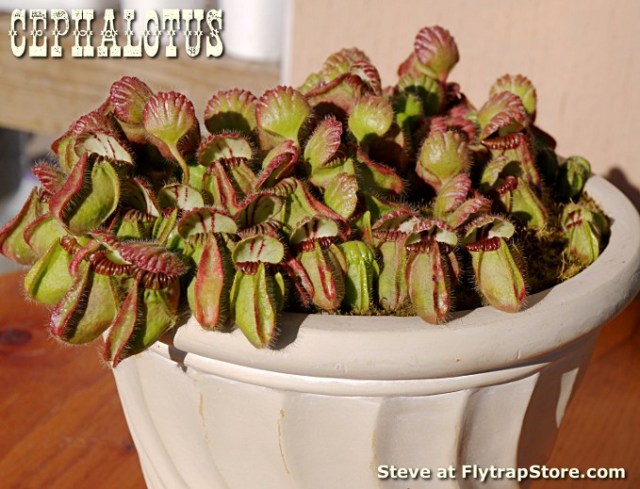QuestionHi,I just received my Cephalotus after a week in the post.
Can you tell me ifa) it is dying or deadb) if is still
alive, how do I save it? Its looks too moist for my liking.
See attached larger photos
http://img72.imageshack.us/img72/8277/p1030317.jpg
http://img51.imageshack.us/img51/1302/p1030318q.jpg
Answer
 Cephalotus Colony
Cephalotus Colony
Hello-- Yes, that Cephalotus looks fairly bad. The growing medium (appears to be pure long-fiber sphagnum moss) is much too dense and soggy. Cephalotus like well drained and aerated soil, and in nature often grow in sandy beachside soil on sharp inclines or cliffs where although moist, the water drains freely, there is plenty of air in the soil, and there is plenty of fresh air movement over and around the plants.
Cephalotus are somewhat susceptible to fungal rot above ground and because of their brittle but soft and fleshy roots, are very susceptible to fungal and bacterial rot underground if not provided with soil that is well drained, holds plenty of air as well as water, does not retain too much water for too long (does not stay saturated or soggy for more than a few hours or a day) and which is is not overwatered (watered too frequently).
If that were my plant, I would immediately place the entire plant, medium, root ball and all, into a bowl of distilled or rain water and carefully remove all of the growing medium from around the roots. Then I would examine the roots carefully to see if any were still light-colored and not rotten. If so, I would use small scissors (surgical scissors, available inexpensively at http://www.drinstruments.com/ for example) to carefully trim away all of the rotten roots, leaves and other tissue, leaving only what still appears to be good tissue. If leaves are discolored but still have some green, I would leave them on the plant for the time being so that they can provide food to the plant through photosynthesis, and only trim them off when they turn completely black. I would then thoroughly rinse the good parts of the plant in fresh distilled or rain water in preparation for planting.
I would plant the Cephalotus in better, looser, more aerated and less water-retentive growing medium in a pot that is comfortably large for it, because if it recovers, its root system will become extensive compared to its top growth, and you will be able to let it grow for a longer time in a larger pot before having to shock it with another transplanting, which Cephalotus often resent and which often sets them back several weeks to several months as they adapt to their new conditions.
The growing medium can be based on traditional sphagnum moss, either light-colored long-fiber dried sphagnum moss or semi-decomposed dark brown sphagnum peat moss, or on coir, which is coconut husk pith after the fibers have been mostly removed (but see note on desalinization of coir below), and should have at least 50% of some other inert, inorganic ingredient such as silica sand (sand composed almost entirely of silicon dioxide (quartz)) or perlite.
If you decide to use coir instead of the easier and usually more easily available sphagnum peat moss, the coir must have the mineral salts that it has absorbed removed by repeated soaking for 8-12 hours and draining, preferably checking the drained water each time with a TDS meter (total dissolved solids meter, a cheap and worthwhile device to have, an HM Digital TDS-EZ for example, http://www.amazon.com/HM-Digital-TDS-EZ-Tester-Purity/dp/B002C0A7ZY ), until the TDS reading is consistently less than 50 parts per million (tap and well water is often between 100-300 parts per million, as a reference).
For much more information and many more helpful comments and suggestions, please join an online carnivorous plant forum such as those listed below, where good growers from around the world can offer their advice.
FlytrapCare.com Forum
http://www.flytrapcare.com/phpBB3/
CPUK Forum
http://www.cpukforum.com/
It appears from the photos that there may still be some life left in your Cephalotus. I would certainly examine it as suggested and try to save it. It may be some months before good growth resumes, if the plant indeed can recover, so you may have to be patient.
Best wishes and good luck.
--Steve






